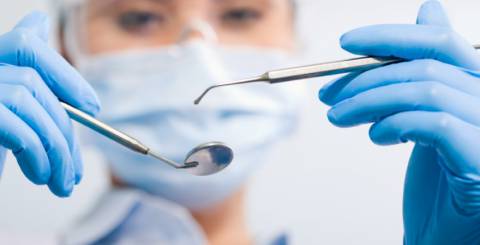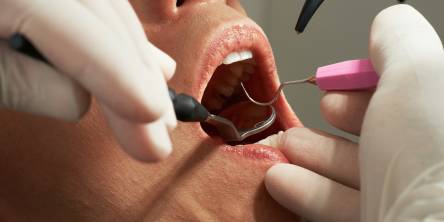The Main Trends in Modern Dentistry

Those days when all dental procedures were performed by eye and touch are gone. Although the result of treatment depends on the intuition and the “good hand” of the doctor, the large-scale implementation of innovative technologies in practice has raised the quality of dental care to a fundamentally different level.
Increasing emphasis is placed on the prevention of oral diseases and aesthetic dentistry. Almost half of the dentist's work today is associated with full aesthetic rehabilitation and not just the treatment of diseased teeth. A beautiful smile and even healthy teeth are a communication tool, an indicator of success and social status. Let's see what technologies doctors offer us today to maintain a beautiful smile:
1. Invisible Braces and Mouth Guards
An incorrect bite or crooked tooth can be corrected thanks to invisible braces that are fixed in the back of the teeth, or transparent mouth guards. The convenience of the latter, in addition to their invisibility, lies in the fact that they can be removed when eating food. But in order to achieve the desired effect quickly, you shouldn’t take them off. It is recommended to wear such mouthguards for a year.
2. Restorations Without Grinding the Tooth
If you are not satisfied with the shape and external condition of a tooth, then this can be corrected with the use of special plates such as dental veneers, lumineers, or ultranirs which are neatly attached to the outer surface of the tooth and eliminate all visible defects.
Veneers and lumineers allow you to change the shape of the tooth without grinding, any injections, and other invasive surgical interventions such as a dental implant procedure. One of the most durable types is ceramic veneers. If the doctor did everything right then they can serve you over 15 years.
3. Virtual Cinema
Many advanced clinics provide patients with special glasses in which the video is projected. This technology has its pros and cons. Among the drawbacks is that films and videos have to be selected according to the specific wishes of the client so that the person is interested in watching. The procedure may also end before the film ends, interrupting the viewing.
In those cases when the procedure is really complex and lengthy, this option may be very helpful and allow the patient to relax and pass the time more comfortably.
4. Micro Bubble Irrigators
How can you further develop oral irrigation? It would seem that you can’t, but recently micro-bubble technology was developed. The essence of this technology lies in using water that is saturated with oxygen bubbles which have an antibacterial effect.
Most of the pathogenic microflora does not tolerate exposure to oxygen and dies. You can choose a lightweight, portable irrigator with several modes. It will not only remove bacteria, plaque and food particles between the teeth but also massage the gums, which improves their blood supply.
5. Gums and Teeth Masks
Everyone has become accustomed to hair and face masks but a mask for the oral cavity still seems like a curiosity even though it is quite practical. These masks soothe sensitive gums and teeth, give enamel shine, and a pleasant aroma. They can be used after cleaning or after professional teeth whitening. According to statistics, at least 30% of people complain of increased teeth sensitivity after this procedure and masks help to relive this.
6. Smart Toothbrush
Smart toothbrushes can whiten teeth and massage gums. You can set various intensities and choose the best nozzle for your teeth. This is done in order to choose the most suitable method of cleaning so as not to damage the teeth with caries or inflamed gums. Such toothbrushes are also often equipped with indicators of bristle wear and battery charge level.
They are able to prompt the optimal time for cleaning each dentition and each side of the tooth surface. All these functions can be pre-programmed through an application for the smartphone.
Similar Articles
The desire for a healthy smile drives approximately 4 million people toward teeth straightening procedures. When it comes to straightening teeth, lingual braces offer a discreet alternative to traditional braces and clear aligners.
As we grow older, our dental needs evolve significantly. The carefree days of childhood tooth fairy visits transform into the more complex world of adult dental care. After age 25, many adults begin to notice changes in their oral health.
Missing teeth can cause a wide range of oral health issues. Nonetheless, over 120 million Americans are missing at least one tooth, and the figure is anticipated to climb as time passes.
A dental emergency doesn’t make an appointment. It shows up unannounced and unapologetic, usually in the middle of the night or during a meal that was supposed to be fun
A dental emergency can strike fast and without warning—during dinner, in the middle of the night, or just before a big meeting.
A wide range of factors can have a direct effect on your oral health. A balanced diet is essential, as is good oral hygiene and regular dental examinations. Many individuals think that nutrition alone can't improve oral health.
The results of wearing Invisalign aligners look stunning, and they are way more convenient than traditional braces. However, no one speaks about what it feels like to wear the same pair of traces around 22 hours a day
Temporomandibular Joint Disorder, commonly known as TMJ, is a condition that causes pain and dysfunction in the jaw joint and surrounding muscles. This disorder can arise from various factors, including teeth grinding, arthritis, jaw injuries, poor posture, or stress.
A root canal is a common treatment that people pay the dentist a visit for. According to a study, root canal treatment claims were up by 42% in the last five years.









